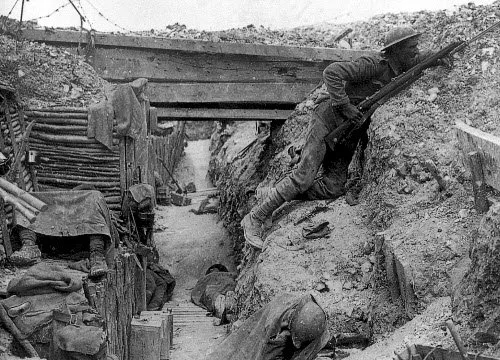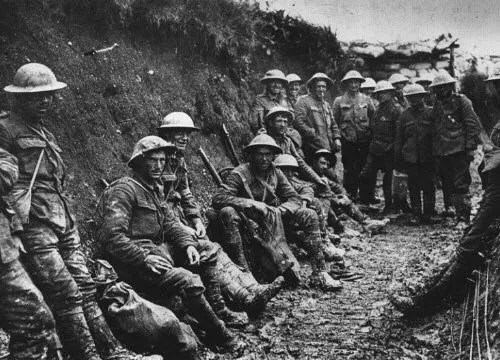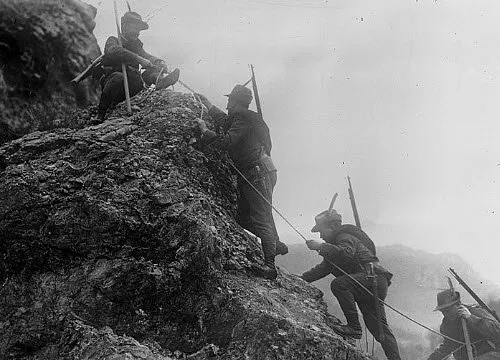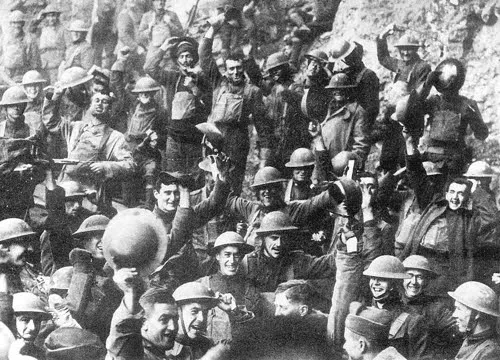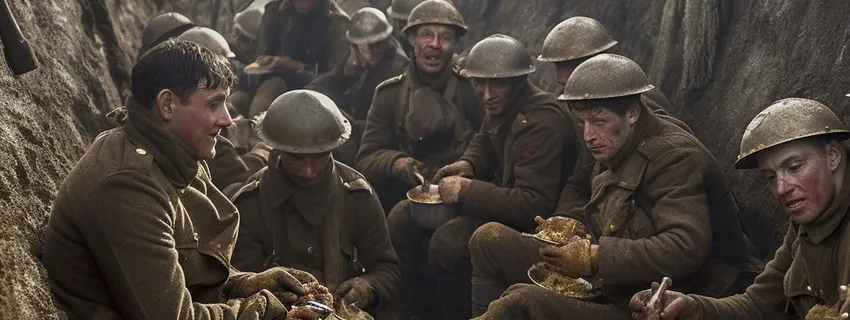Published:
Author: Antonio Maria Guerra
World War I Food Rations
THE RATIONS OF THE WARRING FACTIONS
World War I food rations. What did the soldiers engaged in combat eat? Easy to answer: very unappetizing dishes. And yet their diet became a determining factor in the outcome of the conflict. So let’s find out how the armies of the opposing factions sustained themselves.

Different armies, different types of food.
The quantity and the quality of food provided to troops during the Great War, depended on many factors, including the place where they fought. Battlefields could be very different from each other: nothing to be surprised of, considering that they were scattered across all Europe and outside it. For example, some trenches were on the top of rugged mountains, while others were in the middle of endless plains. That’s why delivering rations, usually prepared in the rear, was often tremendously difficult.
Sometimes soldiers were lucky, thanks to the proximity of a precious supply line. In a few cases, they were stationed in relatively quiet areas and it was possible to hunt or to cultivate small vegetable gardens.
Here follows a general view about the food situation of both the warring factions:
The Central Powers.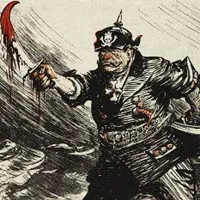 The Central Powers (*1) started the war believing it would be short (*2) and would lead to a fast and easy victory. That’s why they were completely unprepared to support a conflict lasting many years. About this, it’s important to remember that the German and the Austro-Hungarian troops received small rations of food since the beginning of the hostilities, something that was even more evident by confronting them to those provided to the enemy soldiers. This difference appeared quite clear also to the generals of the Kaiser: that’s why they tried almost immediately to cut the delivery of supplies to the Allied armies, using the infamous U-boats to sink their merchant ships.
The Central Powers (*1) started the war believing it would be short (*2) and would lead to a fast and easy victory. That’s why they were completely unprepared to support a conflict lasting many years. About this, it’s important to remember that the German and the Austro-Hungarian troops received small rations of food since the beginning of the hostilities, something that was even more evident by confronting them to those provided to the enemy soldiers. This difference appeared quite clear also to the generals of the Kaiser: that’s why they tried almost immediately to cut the delivery of supplies to the Allied armies, using the infamous U-boats to sink their merchant ships.
The Allies.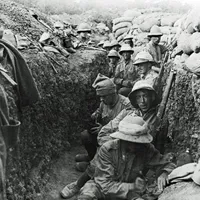 From a nutritional point of view, the Allied troops (*3) were in a better condition than the enemy. This does not mean that the situation was good: soldiers had almost always to fight hunger. The turning point, both in terms of feeding and fighting, was the entry into the war of the AEF, the American Expeditionary Force: starting from 1917, the United States delivered in Europe not only a great number of fresh soldiers, but also a huge amount of supplies. This intervention shattered any attempt of resistance by the Central Powers, causing their ultimate defeat and ending the war.
From a nutritional point of view, the Allied troops (*3) were in a better condition than the enemy. This does not mean that the situation was good: soldiers had almost always to fight hunger. The turning point, both in terms of feeding and fighting, was the entry into the war of the AEF, the American Expeditionary Force: starting from 1917, the United States delivered in Europe not only a great number of fresh soldiers, but also a huge amount of supplies. This intervention shattered any attempt of resistance by the Central Powers, causing their ultimate defeat and ending the war.
Notes:
*1: The ‘Central Powers’ included, among the others, the German Empire, the Austro-Hungarian Empire, the Kingdom of Bulgaria and the Ottoman Empire;
*2: Since the beginning of the Twentieth Century, the German generals were fascinated by the idea of a ‘lightning war’, the ‘blitzkrieg’: a method of warfare they successfully used during the Second World War;
3*: The ‘Allies’ included, among the others, France, the British Empire, the Russian Empire, the Kingdom of Serbia, the Empire of Japan, the Reign of Italy, the Reign of Romania, the United States of America and the Reign of Greece;
What was life like in the trenches during the First World War? How did eat the soldiers forced to live (and die) in these holes? Let’s find out in this article LINK.

“AN ARMY MARCHES ON ITS STOMACH”
(Napoleon Bonaparte)
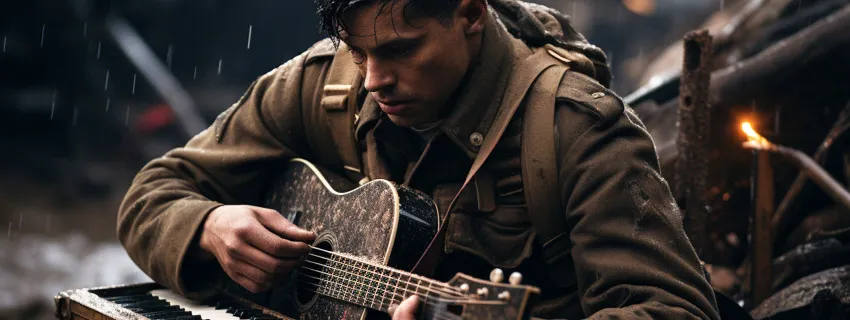
The songs of the Great War.
Some of the most famous songs at the time of the First World War are probably the best choice to accompany the reading of this article:


World War I food rations: shrapnels, sawdust and turnips for the German soldier.
The German soldiers, especially near the end of the war, could enjoy many ‘delicacies’.
Here are a couple of examples:

The ‘Schrapnellsuppe’.
The ‘Schrapnellsuppe’ (splinters soup), was particularly ‘appreciated’ by the troops of the Kaiser. This preparation was often served almost raw: for this reason peas, its main ingredient, were usually hard like bullet shrapnels, hence the name of the exquisite recipe.

Bread, sawdust and turnips.
Due to the lack of supplies, the bread eaten by the German soldiers was often made using flour added with sawdust to increase its quantity.
This ‘exquisite’ bread was frequently accompanied by some very ‘tempting’ turnips jam.

Naval war starves the Central Powers.
Since the beginning of the Great War, each of the warring sides tried to starve the other. To reach this objective, they focused their efforts to destroy the enemy supplies. Great part of them was transported by merchant ships: that’s why the control over the seas became extremely important.
Even if the sneaky U-Boats caused great destruction, the naval blockades imposed by the Allied forces proved decisive.
Read more
It has been estimated that in 1915, the German Empire lost almost half of the materials that used to received before. The loss of fertilizers was particularly serious, causing in a few months a drastic decrease in agricultural production.
The plan organized by Hindenburg (*1) to optimize resources, had no other effect than prolonging the agony. Malnutrition shattered the morale of the troops, lacking the strength needed to fight. The number of victims among the civilians was huge.
Note:
*1: Paul von Hindenburg, German military officer, statesman, and politician;


World War I food rations for the US soldiers.
During the Great War, the US Army proved to be very well prepared to feed its soldiers: this competence derived from specific studies about the nutrition of troops engaged in combat.
Thanks to these studies, the basic ‘garrison ration’, used since the Revolutionary War, was improved creating solutions designed to suit the needs of different warfare scenarios:
Read more
- The ‘reserve ration’ was carried by every soldier in his backpack. It included canned meat, dried bread, sugar, coffee and salt. It was meant to be used when, for whatever reason, it was not possible to eat the food prepared in the field kitchens.
- The ‘trench ration’ was designed to feed a certain number of soldiers. It was used when the food prepared in the field kitchens could be delivered. It included corned beef, sardines, salmon, coffee, salt, sugar and even cigarettes.
- The ’emergency ration’ included highly caloric aliments, such as chocolate. Its most important feature was the great portability. It was also known as ‘armor ration’ or ‘iron ration’, because it was packed in metal containers that could resist to many of the dangers of the combat zones.

The U.S. President Herbert Hoover bets on food.
During the First World War, Herbert Hoover, future President of the United States, directed the U.S. Food Administration. Understanding the great importance of soldiers’ nutrition, he worked very hard to support the war effort by optimizing food production in the United States.
Read more
Among his many initiatives, the ‘victory gardens’: every American citizen was invited to grow one using his backyard. This way he could help the troops fighting in Europe.

World War I food rations: ‘Maconochie’ and ‘Bully Beef’ for the British soldiers.
Among the various types of food eaten by British soldiers during the First World War, two are particularly interesting: the ‘Maconochie soup’ and the ‘bully beef’.

The ‘Maconochie soup’.
The Maconochie canned soup was quite ‘famous’ among the British soldiers during the Great War. This does not mean that they loved it, quite the opposite: for them, it was a necessity, certainly not a pleasure. They despised it so much to say that when it was hot, it was barely edible, when it was cold, it could kill a man. The main ingredients of this preparation include beef, potatoes, carrots, onions, beans, flour, lard and salt.

The ‘Bully Beef’.
‘Bully Beef’ is the english translation of the French ‘boeuf bouilli’. It’s basically corned beef, finely chopped and soaked in gelatin: it can be eaten spread on a slice of bread or directly from the metallic container.
Thanks to its ease of use, this product remained part of the ration of the British soldiers throughout the Twentieth Century, until its replacement in 2009.
It’s particularly interesting to remember what Harry Patch, one of the last veterans of the First World War, said about the rations he received at that time: “… you were lucky if you got some bully beef and a biscuit …”.

World War I food rations: ‘Monkey meat’ for the French soldiers.
French soldiers gave ironic nicknames to the food they ate every day in the trenches. A few examples:
- Canned meat was surnamed ‘monkey meat’ because it was usually branded ‘Madagascar’;
Read more
- Beans and peas were surnamed ‘schrapnells’ (*1), because they were often served raw and hard;
- Lentils were surnamed ‘punaises’ (bugs) for their aspect;
Note:
*1: German word meaning ‘bullet splinters’;
What was life like in the trenches during the First World War? How did eat the soldiers forced to live (and die) in these holes? Let’s find out in this article LINK.
Copyright information.
The images displayed in this page belong to WebFoodCulture and to Mr. Alessandro Dal Ponte, with the exception of:
Public Domain images:
- British soldier in a German trench, 1916 (Wikipedia Link) {PD-US}
- Royal Irish Rifles ration party Somme, 1916 (Wikipedia Link) {PD-US}
- Italian alpine troops during WWI, Agence Rol, 1915 (Wikipedia Link) {PD-US}
- US 64th regiment celebrate the Armistice (Wikipedia Link) {PD-US}
- ‘Only the Navy Can Stop This’, WWI Recruitment poster, 1917 (Wikipedia Link) {PD-US}
- Gallipoli, Soldiers in the trenches, Ernest Brooks, 1915 (Wikipedia Link) {PD-US}
- Can of corned beef by Libby, McNeill & Libby of Chicago (Wikipedia Link) {PD-US}
- Napoleon, 1812, di J.L. David, Nat.Gall. of Art (Wikipedia Link) {PD-US}
- German sub U-14, 1910/1915 (Wikipedia Link) {PD-US}
- Herbert Hoover, 1917 (Wikipedia Link) {PD-US}
Creative Commons Images:
- A maconochie tin on display in the World War I section of the Imperial War Museum in London, photo by Mx. Granger (Wikipedia Link)

